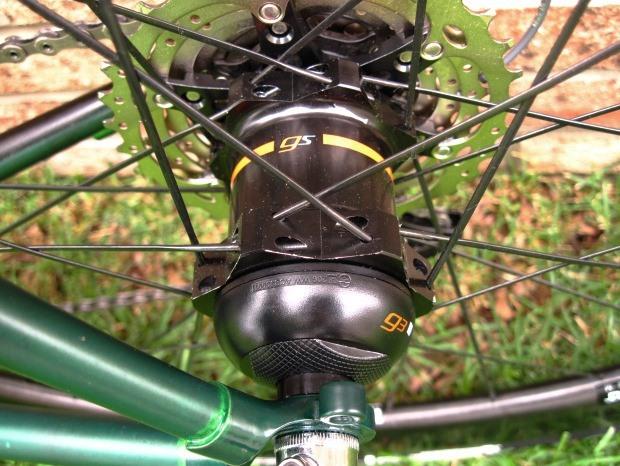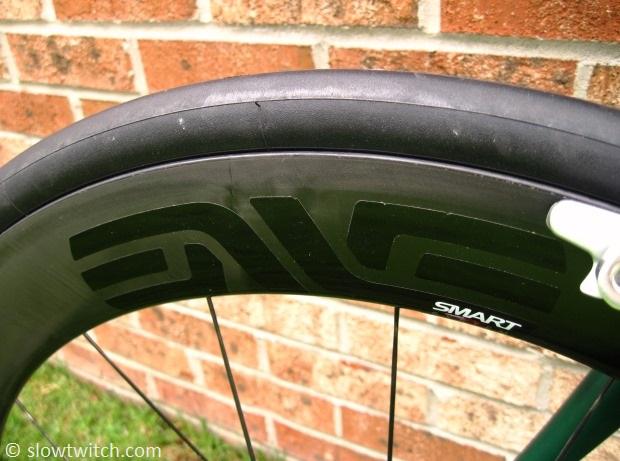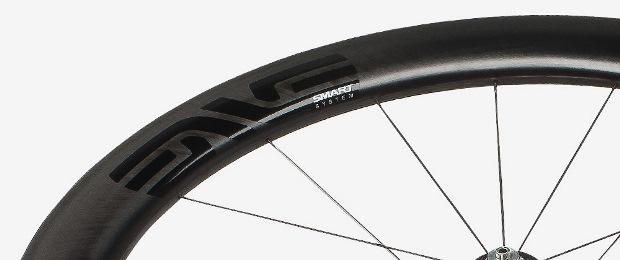You can’t argue that Powertap is well-established in the power meter game. Along with crank-based SRM, they have sold more systems for more years than any other major player today. While some of their earlier hubs had hit-and-miss reliability in poor weather conditions, it seems that all of the products from the past decade or so have been quite solid. I have personally owned four different Powertap wheels prior to this review, and have come to know the product as accurate, consistent, and supported by great customer service in the event of any problem.
That all being said, the power game is changing. Crank-based systems are getting cheaper. Accuracy of all brands will – perhaps inevitably – slowly improve. If you can’t hit the magic +/- 2%, you can’t compete in today’s market at any price.
So – why stick with a hub-based system? To date, it is still the easiest way to share one power meter between two or more bikes; just swap the rear wheels (assuming you have the same diameter wheel and same brake system on both bikes). Sure, you can swap crank-based systems, too, but it requires more time. Also, it assumes that you have the same crank length on all bikes (I don’t), and/or the same chainring sizes on all bikes (again, I don’t). The final point has to do with service. Mark my words: If you train with power long enough, all (yes ALL) systems will need service eventually. It is going to happen. It might take five years, but at some point you will have to send it back to the factory for something. When that happens, a wheel swap is quick – and more of us have spare wheels than cranks.
Also, we’ve said it before: if you ride any non-round ring (Rotor, Osymmetric, etc), hub-based power is the most accurate way to fly. I have heard that some of the newer crank-based systems are finding ways to calculate ‘around’ this problem, but have yet to personally test or evaluate any of them.
Today, we will review Powertap’s latest model, the GS. Their hubs can be built with a myriad of rims, and our test set came with the high-tech Enve SES 6.7 carbon clincher rims. They’re really cool. Sparkly, even. See?

Our readers always want the numbers, so let’s get right to it.
PowerTap GS SES 6.7 Carbon Clincher specifications:
MSRP: $3,600 USD
Weight: 775g front, 947g rear; 1,722 grams/pair
Rim Weights: 520g front, 542g rear
Power Meter accuracy: +/- 1.5%
Front rim dimensions: 60mm depth, 26mm width
Rear rim dimensions: 70mm depth, 24mm width
Compatibility: Shimano/SRAM or Campaganolo 9, 10, and 11-speed
Spokes: DT Swiss Aerolite bladed with internal brass nipples (20f/24r)
Warranty: 2 years
Rider weight limit: None
Includes: Rim tape, ENVE carbon-specific brake pads
My test wheels arrived in a giant-size, very well-protected box.

What’s different about the GS hub? While other Powertap hubs have traditional hub flanges, the GS uses straight-pull spokes:

Powertap says that this results in a stiffer, more responsive wheel, but were not able to provide any data to back this claim. I’ve ridden a non-metric-ton of wheels in my day, and have not been able to discern any sort of blanket difference in hubs with traditional flanges, and those with straight-pull spokes. The rest of the build has too many factors that influence ride quality and stiffness – spoke gauge, spoke count, spoke tension, spoke lacing, rim material, rim depth, overall quality of parts, and so on. I don’t think this makes the GS hub good or bad based on the flanges alone; I’m just trying to confuse your buying decision even further. That’s a joke.
What else is different about this new fancy hub? The larger story is that it features DT Swiss internals, including their Star Ratchet engagement system, seen here:

In my experience, DT bearings are fantastic, and last for a very long time. The ratchet system uses two plates with small ‘teeth’ facing each other for forward engagement. It requires infrequent maintenance, and generally works. Isn’t that what hubs are supposed to do? Mikey likes it.
The other side of the hub features the familiar Powertap ‘guts’ – CR2032 battery, USB plug for firmware updates, and red rubber o-ring for weather sealing. Quoted battery life is 200 hours.

Spoke lacing is radial for the front, and 2x on both sides of the rear wheel.

How about those rims? I’ve read all about Enve’s SES rims, but hadn’t tried them until now. They feature a staggered depth and width for front and rear pairs. This 6.7 set has a 60 x 26mm front rim and 70 x 24mm rear rim.

My tires of choice for this test were the fantastic Michelin Pro 4 700x25mm. Fit between the tire and rim was dead-on perfect – not too tight, not too loose. Note that the wheels do not include valve extenders; I used my favorite removable-core style from Effetto Mariposa in Italy.
I ran about 80 pounds of pressure for most rides; Michelin’s ‘25mm’ tire measures in the 27-28mm range on most modern wide-ish rims, so higher pressure was not necessary or desirable. The ride quality was like full-fat butter pecan ice cream – any chunks in the road were smoothed out in a way that made me say, ‘mmmmm’. Again, Mikey likes.
Overall wheel stiffness seemed to be good, even on steep climbs. Powertap and Enve made a wise choice with the 24-spoke rear wheel. I have gotten rear brake rub on 20-spoke rear wheels that use the nearly-identical Sapim CX-Ray or DT Aerolite spokes, but never with 24-spoke rears. There is no weight limit listed with the wheels, but I would suggest a cutoff of about 225 lbs (102kg).

Enve uses molded-in spoke holes with internal brass nipples, seen above.
Braking quality with Enve’s grey carbon-specific pads and Shimano brake calipers felt quite good. I rank it up with my other favorite carbon rims and pads: Shimano C50/C75 tubulars with Shimano blue pads, and Zipp carbon clinchers with their gray Tangente pads. Initial bite with the Enve’s was a tad too strong for my taste, but overall power was great, and there was no shudder or squeal of any kind. I gave the brakes a very fair shake at Michigan Mountain Mayhem, a mega hilly ride (up AND downhill) with distance options up to 125 miles.
The only kinda-sorta downside with the braking is the fact that you have staggered rim widths. With a 26mm front rim and 24mm rear, you’re not going to match any aluminum wheel set on the market (assuming that you train on different wheels than you race on). Hed’s Ardennes+ will split the difference at 25mm, and several other options clock in around the 23mm mark. This is not an insurmountable issue by any means, but should be taken in to consideration if your bike has a hidden and/or proprietary aero rear brake, such as the Trek Speed Concept, Cannondale Slice RS, or Felt DA.
I rode the wheels on my to-be-reviewed steel road bike from Kona, so brake adjustments were easy-peazy.

Aerodynamics
Of course, we need to discuss the aero story. Enve has a unique one:
“The Smart ENVE System optimizes the interface between the frame surfaces and the wheels, creating an integrated system. The front and rear wheels interact differently with the air and the rest of the bicycle. Rim shapes are optimized to allow airflow to stay attached at higher yaw angles, thus reducing drag and improving ride performance.”
Can I really validate their statements? Sorry, but the closest I can get to a wind tunnel is a box fan and smoke machine in my garage. I can, however, supply you with the aero charts from Enve, seen here:

They say that all tests were done with Vittoria 23mm clincher tires and Continental 22mm tubular tires. We are not aware of where these tests were performed, nor the specific details of the tests (e.g. if they were performed on the same day, same tire pressure, whether or not there was a bike or rider involved, etc). If I had to hazard a guess, I’d say that these Enve rims will perform similarly to other rims of similar depth, width, and shape – which is to say – many other modern carbon wheels.
Power
As for the power meter portion of this test, I only need to say that I had no issues. I’ve already validated Powertap products with a huge battery of tests a couple years ago, and was pointed to this conclusion: The data I see is essentially identical to SRM, who is commonly seen as the technological leader in crank-based power. I have seen similar conclusions from other power junkies whom I trust. I saw nothing strange in my files, and the power numbers ‘felt’ true.
I used this GS hub with the Powertap Joule GPS head unit and my old Garmin 500, transmitting in the standard ANT+ protocol. Powertap also offers a Bluetooth option for those that wish, but I did not test it.

Price
Finally, what about price? The wheel set in this test will run you a cool $3,600. At first, that struck me as expensive, but then I realized two things. First, the SES 6.7 carbon clincher set with standard DT Swiss 240 hubs costs $2,900. Adding this Powertap hub ads $700 to that price, a hefty discount from the standard $1,090 GS hub price. Additionally, Zipp just debuted their new Firestrike 404, which comes in at an identical $3,600, but with no power meter. I never thought I’d say this, but these SES Powertap wheels are starting to look like a bargain in today’s super high end market. Of course, if I was personally going to buy a Powertap, I’d likely buy their low-end hub on an aluminum rim, but these nicer options exist for those with the cash.
If you’re a dedicated Powertap customer and are looking for some wheels for racin’ and goin’ fast, these hoops deserve a look. Their rim dimensions put them in a place that’s useful for both road and triathlon bikes, and overall quality is what you should expect at this price – great. I’d keep riding them around, but (with moderate amounts of sadness on my part), they will be headed back to Wisconsin shortly.




